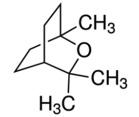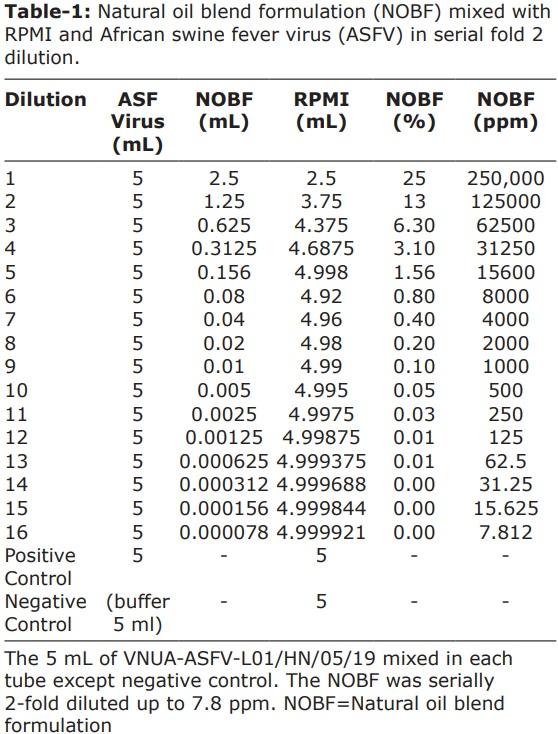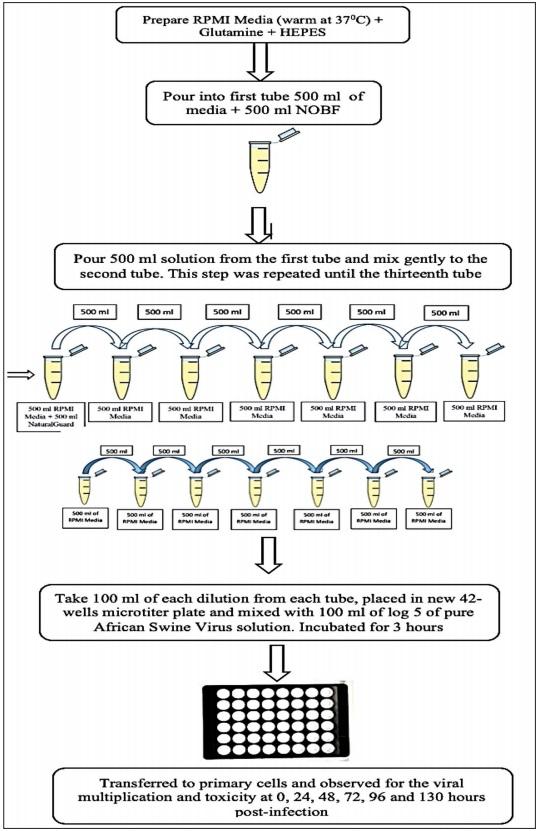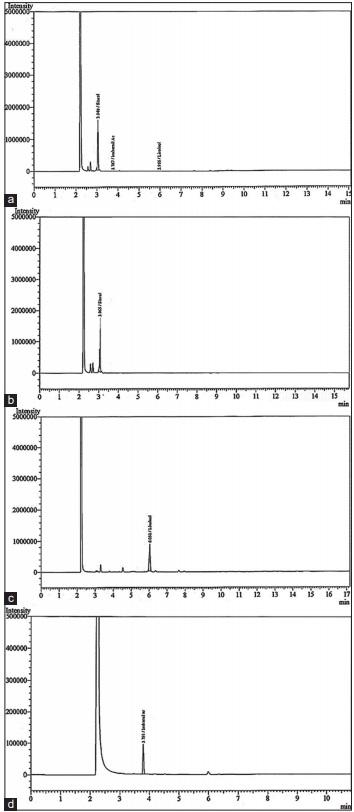Natural oil blend formulation as an anti-African swine fever virus agent in in vitro primary porcine alveolar macrophage culture

Molecular weight: 154.25 g/mol
CAS-No.: 470-82-6
Product number: C80601
Brand: Sigma-Aldrich, USA

Molecular weight: 154.25 g/mol
CAS-No.: 126-91-0
EC-No.: 204-811-2
Product NUMBER: 74856
Brand: Sigma-Aldrich

Molecular weight: 196.29 g/mol
CAS-No.: 125-12-2
EC-No.: 204-727-6
Product number: W216003
Brand: Sigma-Aldrich







1. Rowlands, R.J., Michaud, V., Heath, L., Hutchings, G.,
Oura, C., Vosloo, W., Dwarka, R., Onashvili, T., Albina, E. and Dixon, L.K. (2008) African swine fever virus isolate,
Georgia, 2007. Emerg. Infect. Dis., 14(12): 1870-1874.
2. Penrith, M.L., Vosloo, W., Jori, F. and Bastos, A.D.S. (2013)
African swine fever virus eradication in Africa. Virus Res.,
173: 228-246.
3. Halasa, T., Bøtner, A., Mortensen, S., Christensen, H.,
Toft, N. and Boklund, A. (2016) Simulating the epidemiological and economic effects of an African swine fever epidemic in industrialized swine populations. Vet.
Microbiol., 193:
4. Sánchez-Cordón, P.J., Montoya, M., Reis, A.L. and
Dixon, L.K. (2018) African swine fever: A re-emerging viral disease threatening the global pig industry. Vet. J.,
233: 41-48.
5. World Organization for Animal Health. (2019) Terrestrial
Animal Health Code. World Organization for Animal, Paris.
6. World Organization for Animal Health. (2019) Manual of Diagnostic Tests and Vaccines for Terrestrial Animals.
World Organization for Animal Health, Paris.
7. World Organisation for Animal Health. (2020b) Available from: https://www.oie.int/wahis_2/public/wahid.php/ reviewreport/review?page_refer=mapfulleven-treport&reportid=34283. Retrieved on 19-10-2020.
8. World Organization for Animal Health. (2020a) African
Swine Fever (ASF) Report No. 52: August 21-September
03, 2020. World Animal Health Information Department,
World Organization for Animal Health, Paris, France.
9. Jassim S.A. and Naji M.A. (2003) Novel antiviral agents:
A medicinal plant perspective. J. Appl. Microbiol., 95(3):
412-427.
10. Food and Agriculture Organization. (2018) African Swine
Fever Threatens Peoples Republic of China. Animal Health
Risk Analysis, Assessment No. 5. Food and Agriculture
Organization, Rome, Italy.
11. Juergens, U. (2014) Anti-inflammatory properties of the monoterpene 1.8-cineole: Current evidence for co-medication in inflammatory airway diseases. Drug Res., 64(12):
638-646.
12. Wang, L.H., Madera, R., Li, Y.Z., McVey, S.D.,
Drolet, B.S. and Shi, J. (2020) Recent advances in the diagnosis of classical swine fever and future perspectives.
Pathogens, 9(8): 658.
13. Li, X.D., Zhang, C., Qiao, M.M., Guo, J.S., Xing, G.Y., Jin,
C.X., Wang, J., Sun, M. and Tian, K. (2018) Molecular epidemiology of porcine circovirus Type 3 infection in swine herds in China. Virol. Sin., 33(4): 373-377.
14. Choi, H.J. (2018) Chemical constituents of essential oils possessing anti-influenza A/WS/33 virus activity. Osong
Public Health Res. Perspect., 9(6): 348-353.
15. Takizawa, T., Nakashima, K., Namihira, M., Ochiai, W.,
Uemura, A., Yanagisawa, M., Fujita, N., Nakao, M. and
Taga, T. (2001) DNA methylation is a critical cell-intrinsic determinant of astrocyte differentiation in the fetal brain.
Dev. Cell, 1(6): 749-758.
16. Chenais, E., Ståhl, K., Guberti, V. and Depner, K. (2018)
Identification of wild boar-habitat epidemiologic cycle in
African swine fever epizootic. Emerg. Infect. Dis., 24(4): 810.
17. Probst, C., Gethmann, J., Amler, S., Globig, A., Knoll, B. and Conraths, F.J. (2019) The potential role of scavengers in spreading African swine fever among wild boar. Sci. Rep.,
9(1): 11450.
18. Reed, L.J. and Muench, H.A. (1938) Simple method of estimating fifty percent endpoints. Am. J. Hyg., 27(3): 493-497.
19. King, D.P., Reid, S.M., Hutchings, G.H., Grierson, S.S.,
Wilkinson, P.J., Dixon, L.K., Bastos, A.D.S. and Drew, T.W. (2003) Development of a TaqMan® PCR assay with internal amplification control for the detection of African swine fever virus. J. Virol. Methods, 107(1): 53-61.
20. Jürgen, R., Schnitzler, P., Suschke, U. and Saller, R. (2009)
Essential oils of aromatic plants with antibacterial, antifungal, antiviral, and cytotoxic properties an overview. Forsch.
Komplement. Med., 16(2): 79-90.
21. Simoes, M., Martins, C. and Ferreira, F. (2015) Early intranuclear replication of African swine fever virus genome modifies the landscape of the host cell nucleus. Virus Res.,
210: 1-356.
22. Chenais, E., Boqvist, S., Sternberg-Lewerin, S.,
Emanuelson,U., Ouma, E., Dione, M., Aliro, T., Crafoord, F.,
Masembe, C. and Stahl, K. (2017a) Knowledge, attitudes and practices related to African swine fever within smallholder pig production in Northern Uganda. Transbound.
Emerg. Dis., 64(1): 101-115.
23. Chenais, E., Boqvist, S., Emanuelson, U., von Bromssen, C.,
Ouma, E., Aliro, T., Masembe, C., Stahl, K. and SternbergLewerin, S. (2017b) Quantitative assessment of social and economic impact of African swine fever outbreaks in
Northern Uganda. Prev. Vet. Med., 144(1): 134-148.
24. Beltrán-Alcrudo, D., Arias, M., Gallardo, C., Kramer, S. and Penrith, M.L. (2017) African Swine Fever: Detection and Diagnosis a Manual for Veterinarians. FAO Animal
Production and Health Manual No. 19. Food and Agriculture
Organization of the United Nations, Rome. p88.
25. Depner, K., Gortazar, C., Guberti, V., Masiulis, M., More, S. and Oļševskis, E. (2017) Epidemiological analyses of
African swine fever in the Baltic states and Poland. EFSA
J., 15(11): 5068.
26. Cappai, S., Rolesu, S., Coccollone, A, Laddomada, A. and
Loi, F. (2018) Evaluation of biological and socio-economic factors related to persistence of African swine fever in
Sardinia. Prev. Vet. Med., 152(1): 1-11.
27. Simoes, M., Ferreira, F.B., Leitao, A., Martins, C. and
Ferreira, F. (2019) African swine fever virus replication events and cell nucleus: New insights and perspectives.
Virus Res., 270: 197667.
28. Gostner, J.M., Ganzera, M., Becker, K., Geisler, S.,
Schroecksnadel, S., Überall, F., Schennach, H. and Fuchs, D. (2014). Lavender oil suppresses indoleamine 2,3-dioxygenase activity in human PBMC. BMC Complement. Altern.
Med., 14: 503.
29. Shellie, R., Mondello, L., Philip, M. and Giovanni, D. (2002) Characterization of lavender essential oils by using gas chromatography-mass spectrometry with correlation of linear retention indices and comparison with comprehensive two-dimensional gas chromatography. J. Chromatogr.
A, 970(1-2): 225-234.
30. Juergens, U.R., Dethlefsen, U., Steinkamp, G., Gillissen,A.,
Repges, R. and Vetter, H. (2003) Anti-inflammatory activity of 1.8-cineol (eucalyptol) in bronchial asthma: A double-blind placebo-controlled trial. Respir. Med., 97(3):
250-256.
31. Juergens, U.R., Engelen, T., Racké, K., Stöber, M.,
Gillissen, A. and Vetter, H. (2004) Inhibitory activity of
1,8-cineol (eucalyptol) on cytokine production in cultured human lymphocytes and monocytes. Pulm. Pharmacol.
Ther., 17(5): 281-287.
32. Serafino, A., Vallebona, P.S., Andreola, F., Zonfrillo, M.,
Mercuri, L., Federici, M., Rasi, G., Garaci, E. and
Pierimarchi, P. (2008) Stimulatory effect of Eucalyptus essential oil on innate cell-mediated immune response.
BMC Immunol., 9: 17.
33. Göbel, H., Schmidt, G. and Soyka, D. (1994) Effect of peppermint and Eucalyptus oil preparations on neurophysiological and experimental algesimetric headache parameters.
Cephalalgia, 14(3): 228-234.
34. Astani, A., Reichling, J. and Schnitzler, P. (2010)
Comparative study on the antiviral activity of selected monoterpenes derived from essential oils. Phytother. Res.,
24(5): 673-679.
35. Karger, A., Pérez-Núñez, D., Urquiza, J., Hinojar, P.,
Alonso, C., Freitas, F.B., Revilla, Y., Le Potier, M.F. and
Montoya, M. (2019) An update on african swine fever virology. Viruses, 8(9): 864-878.
36. Yoo, D., Kim, H., Lee, J.Y. and Yoo, H.S. (2020) African swine fever: Etiology, epidemiological status in Korea, and perspective on control. J. Vet. Sci., 21(2): 38.
37. Salguero, F.J. (2020) Comparative pathology and pathogenesis of African swine fever infection in swine. Front. Vet.
Sci., 19(7): 282-295.
38. Hess, W.R., Endris, R.G., Haslett, T.M., Monahan, M.J. and
McCoy, J.P. (1987) Potential arthropod vectors of African swine fever virus in North America and the Caribbean basin. Vet. Parasitol., 26(1-2): 145-155.
39. do, I. and Alonso, C. (2017) African swine fever virus: A review. Viruses, 9(5): 103.
40. Gallardo, C., Fernández-Pinero, J. and Arias, M. (2019)
African swine fever (ASF) diagnosis, an essential tool in the epidemiological investigation. Virus Res., 271(10): 197676.
41. Dixon, L.K., Islam, M., Nash, R. and Reis, A.L. (2019)
African swine fever virus evasion of host defences. Virus
Res., 266(1): 25-33.
42. Juszkiewicz, M., Walczak, M., Mazur-Panasiuk, N. and
Woźniakowski, G. (2019) Virucidal effect of chosen disinfectants against African swine fever virus (ASFV) preliminary studies. Pol. J. Vet. Sci., 22(4): 777-780.
43. Kouam, M.K., Jacouba, M. and Moussala, J.O. (2020)
Management and biosecurity practices on pig farms in the
Western Highlands of Cameroon (Central Africa). Vet. Med.
Sci., 6(1): 82-91.
44. Revilla, Y., Perez-Nunez, D. and Richt, J.A. (2018) African swine fever virus biology and vaccine approaches. Adv.
Virus Res., 100(1): 41-44.
45. Gallardo, C., Sánchez, E.G., Pérez-Núñez, D., Nogal, M., de León, P., Carrascosa, Á.L. and Revilla, Y. (2018a).
African swine fever virus (ASFV) protection mediated by
NH/P68 and NH/P68 recombinant live-attenuated viruses.
Vaccine, 36(19): 2694-2704.
46. Reis, A.L., Abrams, C.C., Goatley, L.C., Netherton, C.,
Chapman, D.G., Sanchez-Cordon, P. and Dixon, L.K. (2016). Deletion of African swine fever virus interferon inhibitors from the genome of a virulent isolate reduces virulence in domestic pigs and induces a protective response.
Vaccine, 34(39): 4698-4705.
47. Reis, A.L., Goatley, L.C., Jabbar, T., Pedro, J., SanchezCordon, P.J., Christopher, L. and Dixon, L.K. (2017b)
Deletion of the African swine fever virus gene DP148R does not reduce virus replication in culture but reduces virus virulence in pigs and induces high levels of protection against challenge. J. Virol., 91(24): e01428-17.
48. Sánchez-Cordón, P.J., Jabbar, T., Berrezaie, M.,
Chapman, D., Reis, A., Sastre, P. and Dixon, L.K. (2018b)
Evaluation of protection induced by immunisation of domestic pigs with deletion mutant African swine fever virus BeninΔMGF by different doses and routes. Vaccine,
36(5): 707-715.
49. Gallardo, C., Soler, A., Rodze, L., Nieto, R., CanoGómez, C., Jovita Fernandez-Pinero, J. and Arias, M. (2018b). Attenuated and non-haemadsorbing (non-HAD) genotype II African swine fever virus (ASFV) isolated in
Europe, Latvia 2017. Trans. Emerg. Dis., 66(3):1399-1404.








